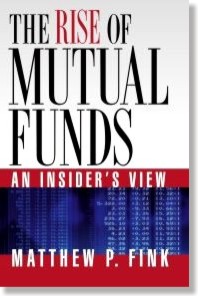

![]() formation of the first mutual funds in the roaring 20s
formation of the first mutual funds in the roaring 20s
![]() how the 1929 stock market crash, a disaster for most financial institutions, spurred the growth of mutual funds
how the 1929 stock market crash, a disaster for most financial institutions, spurred the growth of mutual funds
![]() establishment in 1934, over FDR’s objection, of the United States Securities and Exchange Commission, the federal agency that regulates mutual funds
establishment in 1934, over FDR’s objection, of the United States Securities and Exchange Commission, the federal agency that regulates mutual funds
![]() enactment of the Revenue Act of 1936, the tax law that saved mutual funds from extinction
enactment of the Revenue Act of 1936, the tax law that saved mutual funds from extinction
![]() the unexpected passage of the Investment Company Act of 1940, the “constitution” of the mutual fund industry
the unexpected passage of the Investment Company Act of 1940, the “constitution” of the mutual fund industry
![]() the creation in 1972 of money market funds, which totally changed the U.S. financial system
the creation in 1972 of money market funds, which totally changed the U.S. financial system
![]() enactment of the Employee Retirement Income Security Act of 1974, which created Individual Retirement Accounts
enactment of the Employee Retirement Income Security Act of 1974, which created Individual Retirement Accounts
![]() the accidental development of 401(k) plans, which have revolutionized
the accidental development of 401(k) plans, which have revolutionized
the way Americans save for retirement
![]() the 2003 trading abuses, the greatest scandal ever in the history of the mutual fund industry
the 2003 trading abuses, the greatest scandal ever in the history of the mutual fund industry
![]() The crisis did not result from a lack of regulatory tools, but from regulators’ failure to utilize tools they possessed: The SEC exempted asset-backed pools from regulation, repealed the uptick rule on short-sales, and lowered capital standards for securities firms. The Federal Reserve Board declined to crack-down on unscrupulous lending practices, and, most importantly, the Fed refused to raise interest rates to curb excessive housing speculation
The crisis did not result from a lack of regulatory tools, but from regulators’ failure to utilize tools they possessed: The SEC exempted asset-backed pools from regulation, repealed the uptick rule on short-sales, and lowered capital standards for securities firms. The Federal Reserve Board declined to crack-down on unscrupulous lending practices, and, most importantly, the Fed refused to raise interest rates to curb excessive housing speculation
![]() Mutual funds were hit hard by the crisis, but fared considerably better than other institutions, such as hedge funds, banks, and securities firms, that employed leverage far in excess of that permitted for mutual funds
Mutual funds were hit hard by the crisis, but fared considerably better than other institutions, such as hedge funds, banks, and securities firms, that employed leverage far in excess of that permitted for mutual funds
![]() The crisis caused the first large money market fund to fall below one dollar per share, leading the SEC to tighten its regulation of money funds. But it would be perverse to subject money funds to bank regulation. Taxpayers have paid billions to bail out banks, whereas money funds, regulated by the SEC, have not cost taxpayers one cent
The crisis caused the first large money market fund to fall below one dollar per share, leading the SEC to tighten its regulation of money funds. But it would be perverse to subject money funds to bank regulation. Taxpayers have paid billions to bail out banks, whereas money funds, regulated by the SEC, have not cost taxpayers one cent
![]() In the wake of the crisis there were calls to limit the size and activities of financial institutions. The Administration and Congress rejected this approach, and instead the Dodd-Frank Act granted regulators, who produced the crisis, even more authority. We are headed toward a
In the wake of the crisis there were calls to limit the size and activities of financial institutions. The Administration and Congress rejected this approach, and instead the Dodd-Frank Act granted regulators, who produced the crisis, even more authority. We are headed toward a
world of giant financial conglomerates that are too big to manage or
regulate, riddled with conflicts, and periodically in need of massive government bailouts
![]() The most important event in fund history
The most important event in fund history
![]() The worst event in fund history
The worst event in fund history
![]() The most important person in fund history
The most important person in fund history
The Rise of Mutual Funds: An Insider’s View describes the developments that have produced mutual funds’ long history of success. Among these developments are:

Second, enlarged edition
published 2011
see below